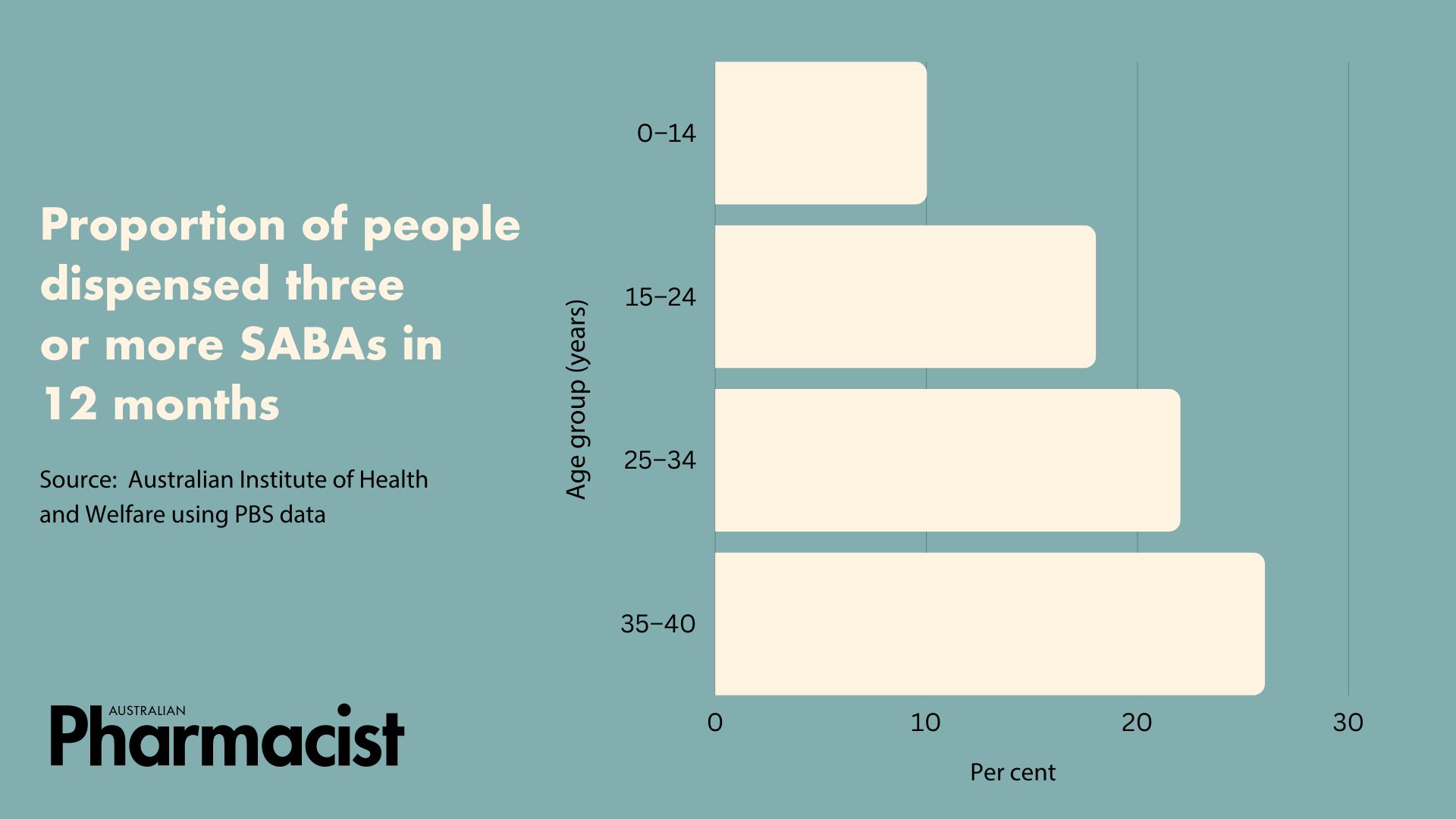Over reliance on short-acting beta2-agonists (SABAs) is drastically undermining asthma control. Ahead of National Asthma Awareness Week (1–7 September 2023), pharmacists should educate patients about the risks of SABA overuse.
Asthma is one of the most prevalent chronic diseases in Australia, accounting for 2.5% of total disease burden last year and 351 deaths in 2021.
Around 2.7 million Australians (11%) have asthma, and the condition is even more endemic among Aboriginal and Torres Strait Islander people, with almost one in five reported to have asthma in 2018–19.

As the leading cause of total burden in children aged 1–14 years, asthma also significantly impacts the nation’s youth.
But beyond the health effects, asthma also impacts Australia’s bottom line – costing the health system $900 million in 2019–2020 alone. The Pharmaceutical Benefits Scheme (PBS) proportion of asthma expenditure is particularly large in comparison to the average, accounting for more than four times the proportion for total health expenditure (51% versus 12%).
A significant contributor to the issue is patients’ underuse of preventative medicines and over reliance on SABAs.
But pharmacists can better support people living with asthma by encouraging a movement away from relievers and towards preventers.
SABAs undermining asthma care
Recent analysis of dispensed prescriptions shows 24% of Australians have difficult-to-treat asthma, with one in five of these patients having uncontrolled disease.
There is wide variation across regions of Australia, with difficult-to-treat asthma most prevalent in Western Australia. Parts of Northern Territory, Victoria, Tasmania and NSW also had regions with high prevalence.
Most adults and adolescents with asthma should be treated with low-dose inhaled corticosteroids (ICS) together with fast-acting bronchodilators for symptom relief.
However, through analysis of PBS data, the Australian Institute of Health and Welfare reports only one third of people with asthma who were dispensed a preventer under the PBS were dispensed the medicine three or more times within 12 months.
On the other hand, analysis of 2021–22 PBS data revealed almost one fifth (18%) of Australians aged 40 and under dispensed at least one SABA reliever were dispensed to three or more times within 12 months.
The National Asthma Council (NAC) Australian Asthma Handbook defines high SABA use as more than 3 canisters per year, or 1.6 or more inhalations per day. Over reliance on relievers contributes to increased:
- airway hyperresponsiveness
- asthma-related mortality
- healthcare utilisation due to asthma.
Furthermore, when patients underutilise preventers and over-rely on SABAs, they are at risk of:
- poor asthma control
- needing oral corticosteroids
- exacerbations, hospitalisation, and death.
When SABA use escalates to 12 or more canisters per year, the risk of death from asthma compared to two or fewer canisters per year more than doubles.
When those with poor asthma control lean on oral corticosteroids, they face a range of different health risks. As few as four or five short courses of prednisone or prednisolone over a lifetime is associated with an increased risk of adverse effects such as osteoporosis, pneumonia, cataracts and diabetes.
Time for action
As SABAs have no anti-inflammatory effect, they neither treat the underlying inflammation nor protect against asthma exacerbations. The continued reliance on SABA relievers leaves patients across all asthma severities at risk of preventable attacks.
The availability of SABAs without a prescription in pharmacies promulgates consumer perceptions that asthma is an intermittent condition rather than a chronic inflammatory disease.
There have been continued calls to review the availability of pharmacy-only SABAs. In the meantime, pharmacists need to better identify people who over-rely on their SABA inhaler for symptomatic relief, at the expense of ICS maintenance therapy.
This includes assessing asthma control each time SABA is dispensed in a pharmacy. The Asthma Control Test can be used to review asthma control over the previous four weeks, with good control defined as:
- daytime symptoms 2 or less days per week
- need for SABA reliever 2 or less days per week
- no limitation of activities
- no symptoms during the night or on waking.
Asthma continues to be a major but avoidable burden on the Australian healthcare system, with growing environmental threats such as climate change, thunderstorm asthma and smoke exposure presenting a major challenge to asthma control.
Community pharmacists need to play a greater role in patient education and awareness of asthma-related harms, and encourage patients requesting SABA relievers to visit their GP for a review of their asthma.
Debbie Rigby FPS is Clinical Executive Lead at the National Asthma Council Australia.



 John Jones MPS, pharmacist immuniser and owner of My Community Pharmacy Shortland in Newcastle, NSW[/caption]
John Jones MPS, pharmacist immuniser and owner of My Community Pharmacy Shortland in Newcastle, NSW[/caption]


 Debbie Rigby FPS explaining how to correctly use different inhaler devices[/caption]
Debbie Rigby FPS explaining how to correctly use different inhaler devices[/caption]




 Professor Sepehr Shakib[/caption]
Professor Sepehr Shakib[/caption]

 Lee McLennan MPS[/caption]
Lee McLennan MPS[/caption]
 Dr Natalie Soulsby FPS, Adv Prac Pharm[/caption]
Dr Natalie Soulsby FPS, Adv Prac Pharm[/caption]
 Joanne Gross MPS[/caption]
Joanne Gross MPS[/caption]








